Qualitative Analysis of a Leslie-Gower Predator-Prey System with Nonlinear Harvesting in Predator
Abstract
This paper deals with the study of the stability and the bifurcation analysis of a Leslie-Gower predator-prey model with Michaelis-Menten type predator harvesting. It is shown that the proposed model exhibits the bistability for certain parametric conditions. Dulac’s criterion has been adopted to obtain the sufficient conditions for the global stability of the model. Moreover, the model exhibits different kinds of bifurcations (e.g., the saddle-node bifurcation, the subcritical and supercritical Hopf bifurcations, Bogdanov-Takens bifurcation, and the homoclinic bifurcation) whenever the values of parameters of the model vary. The analytical findings and numerical simulations reveal far richer and complex dynamics in comparison to the models with no harvesting and with constant-yield predator harvesting.
1. Introduction
Marine life is a renewable natural resource that not only provides food to a large population of humans but also is involved in the regulation of the Earth’s ecosystem. The growing human needs for more food and more energy have led to increased exploitation of these resources which affects the Earth’s ecosystem. Thus, it is imperative to design harvesting strategies which aim at maximizing economic gains giving due consideration to the ecological health of the concerned Earth’s ecological system. Mathematical modeling in harvesting of species was started by Clark [1, 2]. There are mainly three types of harvesting according to Gupta et al. [3]: (i) h(x) = h, constant rate harvesting (see [4–7]), (ii) h(x) = qEx, proportionate harvesting (see [8, 9]), and (iii) h(x) = qEx/(m1E + m2x) (Holling type II), nonlinear harvesting (see [10–13]). Nonlinear harvesting is more realistic and exhibits saturation effects with respect to both the stock abundance and the effort level. Notice that h(x) → qE/m2 as x → ∞ and h(x) → qE/m1 as E → ∞.
The objective of the present work is to study dynamical behaviors of a Leslie-Gower predator-prey model in the presence of nonlinear harvesting in predators depending on parameters of the model. There have been many papers on the Leslie-Gower predator-prey system with harvesting. For example, May et al. [14] proposed a Leslie-Gower predator-prey model in which two different kinds of constant-yield harvesting applied on both prey and predator species have been considered and this model was studied by Beddington and Cooke [15]. Beddington and May [16] proposed and studied Leslie-Gower predator-prey model when both the prey and predators were harvested with constant effort. Beddington and Cooke [15] studied a Leslie-Gower predator-prey model in which the preys are harvested at a constant-yield rate and predators are harvested with constant-effort rate. Zhu and Lan [17] studied a Leslie-Gower predator-prey model with constant-yield prey harvesting. Gong and Huang [18] studied the Bogdanov-Takens bifurcation for the model and showed that for different parameter values the model has a limit cycle or a homoclinic loop. Gupta et al. [3] discussed the bifurcation analysis of a Leslie-Gower prey-predator model in the presence of nonlinear harvesting in prey. Huang et al. [19] studied the effect of constant-yield predator harvesting on the dynamics of a Leslie-Gower type model and showed that the model has Bogdanov-Takens (BT) singularity of codimension 3 or a weak focus of multiplicity two for some parameter values. They have shown that as the parameters change, the model exhibits saddle-node bifurcation, repelling and attracting B-T bifurcations, and supercritical, subcritical, and degenerate Hopf bifurcations.
This article is organized as follows. In Section 2, we describe the mathematical model in detail. In Section 3, we obtain the number and location of equilibrium points and the local and global stability of the equilibria are investigated. In Section 4, the existence of saddle-node, Hopf, and Bogdanov-Takens bifurcations is shown. In Section 5, we present several numerical simulations that support our theoretical results. Finally, we present some ramification of our results in Section 6.
2. Model Equations
2.1. Leslie-Gower Model
2.2. Harvested Model
3. Equilibria and Their Local Stability
The quadratic equation (6) has two positive roots and whenever (say), a double positive root x3 = (1 + 2β + c + βc − h)/2(1 + β) whenever , and no positive root whenever . The number and location of the equilibrium points of system (5) lying in the set Ω are given in the following lemma.
Lemma 1. System (5) has
- (a)
four equilibrium points, trivial equilibrium point E0 = (0,0), axial equilibrium point e = (1,0), and two interior equilibrium points E1 = (x1, y1) and E2 = (x2, y2) whenever , where , , , , and ;
- (b)
three equilibrium points, trivial equilibrium point E0 = (0,0), axial equilibrium point e = (1,0), and a double interior equilibrium point E3 = (x3, y3) whenever , where and ;
- (c)
three equilibrium points, trivial equilibrium point E0 = (0,0), axial equilibrium point e = (1,0), and an interior equilibrium point E4 = (x4, y4) whenever c = h and βc < 1, where x4 = β(1 + c)/(1 + β) and y4 = (1 − βc)/(1 + β);
- (d)
three equilibrium points, trivial equilibrium point E0 = (0,0), axial equilibrium point e = (1,0), and an interior equilibrium point E5 = (x5, y5) whenever h < c, where and ;
- (e)
two equilibrium points, trivial equilibrium point E0 = (0,0), and axial equilibrium point e = (1,0) whenever and c < h.
The number and location of interior equilibrium points have been depicted in Figure 1.
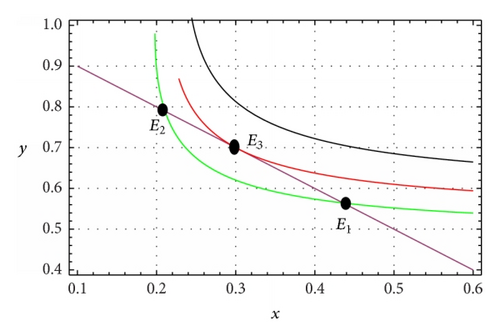
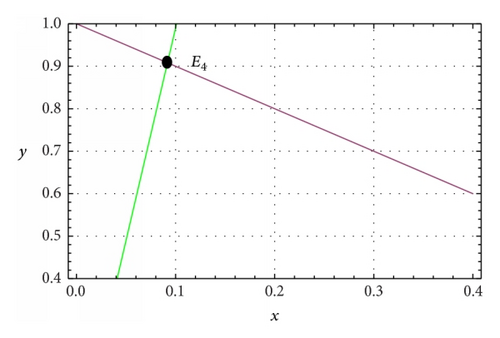
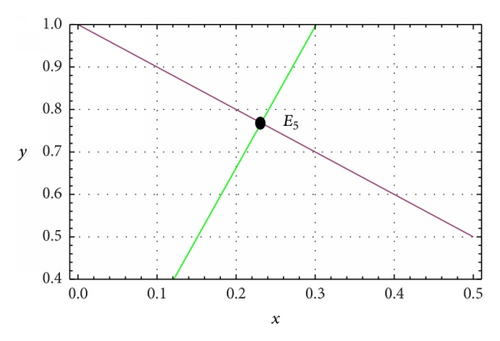
Theorem 2. The trivial equilibrium point E0 of system (5) is a saddle point.
Theorem 3. (a) The equilibrium point e is asymptotically stable whenever c < h and a saddle whenever h < c.
(b) The equilibrium point E1, if existent, is always a saddle point.
(c) The equilibrium point E2, if existent, is asymptotically stable whenever (ρy2/x2)((x2 − 2βy2 − βc)/(c + y2)) − x2 < 0 and is unstable whenever (ρy2/x2)((x2 − 2βy2 − βc)/(c + y2)) − x2 > 0.
(d) The equilibrium point E3, if existent, is a degenerate singular point.
(e) The equilibrium point E4, if existent, is always asymptotically stable.
(f) The equilibrium point E5, if existent, is asymptotically stable whenever (ρy5/x5)((x5 − 2βy5 − βc)/(c + y5)) − x5 < 0 and is unstable whenever (ρy5/x5)((x5 − 2βy5 − βc)/(c + y5)) − x5 > 0.
Proof. (a) The eigenvalues of the Jacobian matrix Je are −1 and ρ(1 − h/c), so the equilibrium point e is asymptotically stable whenever c < h and a saddle whenever h < c.
(b) The determinant , so the interior equilibrium point E1 is a saddle point.
(c) The determinant and , so the interior equilibrium point E2 is asymptotically stable whenever (ρy2/x2)((x2 − 2βy2 − βc)/(c + y2)) − x2 < 0 and unstable whenever (ρy2/x2)((x2 − 2βy2 − βc)/(c + y2)) − x2 > 0.
(d) The determinant , so the interior equilibrium point E3 is a degenerate singular point.
(e) The determinant as βc < 1 and always, so the interior equilibrium point E4 is always asymptotically stable.
(f) The determinant and , so the interior equilibrium point E5 is asymptotically stable whenever (ρy5/x5)((x5 − 2βy5 − βc)/(c + y5)) − x5 < 0 and unstable whenever (ρy5/x5)((x5 − 2βy5 − βc)/(c + y5)) − x5 > 0.
From Lemma 1, if h = c, system (5) has unique interior equilibrium point E4, and if h < c, system (5) has unique interior equilibrium point E5. In Theorem 3, it is proved that these interior equilibrium points are always asymptotically stable. Now we show that these equilibrium points are globally asymptotically stable.
Theorem 4. The equilibrium points E4 and E5, if existent, are globally asymptotically stable.
Proof. From Lemma 1, system (5) has one trivial equilibrium point E0, one axial equilibrium point e, and one interior equilibrium point E4 whenever h = c. Further, it has one trivial equilibrium point E0, one axial equilibrium point e, and one interior equilibrium point E5 whenever h < c. Also, from Theorem 3, the trivial equilibrium point E0 is always a saddle point, axial equilibrium point e is a saddle point whenever h ≤ c, and the interior equilibrium points E4 and E5 are asymptotically stable. We define the following function:
After simplification, we obtain L(x, y) = −(1/y2)(1 + (y2 + (c − h)(c + 2y))/x(c + y) 2) < 0 as h = c or h < c. Thus, by using Dulac’s criterion [24], system (5) will not have any nontrivial periodic orbit in Ω. Note that y-axis and x-axis are the stable manifolds of the trivial and the axial equilibrium points, respectively. Using this in conjunction with the Poincare-Bendixson theorem [24] gives us that the interior equilibrium points E4 and E5 will be globally stable.
In Theorem 3, it is shown that the equilibrium point E3 is a degenerate singular point. Now we study the property of this point.
Theorem 5. The equilibrium point E3, if existent, is
- (a)
a saddle-node whenever (ρy3/x3)((x3 − 2βy3 − βc)/(c + y3)) − x3 ≠ 0;
- (b)
a cusp of codimension 2 whenever (ρy3/x3)((x3 − 2βy3 − βc)/(c + y3)) − x3 = 0.
Proof. First, we shall shift the equilibrium point E3 = (x3, y3) to the origin by using the transformations u1 = x − x3 and v1 = y − y3; system (5) reduces into the form
In Section 4, we shall study the bifurcations occurring in system (5).
4. Bifurcation Analysis
4.1. Hopf Bifurcation
In Theorem 3, it is shown that the interior equilibrium point E2 is stable whenever (ρy2/x2)((x2 − 2βy2 − βc)/(c + y2)) − x2 < 0 and unstable whenever (ρy2/x2)((x2 − 2βy2 − βc)/(c + y2)) − x2 > 0. Now, we consider the parametric condition (ρy2/x2)((x2 − 2βy2 − βc)/(c + y2)) − x2 = 0. In this parametric condition, the equilibrium point E2 is a weak focus or a center. Hence, system (5) may enter a Hopf bifurcation at the point E2. In this subsection, we consider the parameter ρ as the Hopf bifurcation parameter and discuss the conditions under which the stability of E2 will change and system (5) exhibits Hopf bifurcations.
Theorem 6. System (5) undergoes a Hopf bifurcation with respect to parameter ρ around the equilibrium point E2, if existent, whenever (ρy2/x2)((x2 − 2βy2 − βc)/(c + y2)) − x2 = 0. Moreover,
- (a)
the equilibrium point E2 is a weak focus of multiplicity 1 if the parameter set (ρ, β, h, c) is in Hsup or Hsub and is stable and unstable according to whether (ρ, β, h, c) is in Hsup or Hsub;
- (b)
system (5) has at least one unstable limit cycle whenever (ρ, β, h, c) is in Hsub, 0 < ρ < ρ∗ and |ρ − ρ∗| ≪ 1, and at least one stable limit cycle whenever (ρ, β, h, c) is in Hsup, ρ > ρ∗ and |ρ − ρ∗| ≪ 1.
Proof. A critical magnitude of the bifurcation parameter exists as 1 − βc − (1 + 2β)y2 ≠ 0 such that, at ρ = ρ∗, tr(JE) = 0 and det(JE) > 0. In order to ensure the existence of a Hopf bifurcation, we have to check the transversality condition (see [24]). We have as 1 − βc − (1 + 2β)y2 ≠ 0. Hence, the transversality condition for a Hopf bifurcation is satisfied. To determine the direction of Hopf bifurcation and stability of E2, we compute the first Liapunov coefficient of system (5) at the equilibrium point E2.
Let x = u − x2 and y = v − y2; then, the equilibrium point E2 is shifted to the origin (0,0) and system (5) can be rewritten as
From the discussion above, the equilibrium point E2 of system (5) is a weak focus of multiplicity 1 and is unstable if (ρ, β, h, c) is in Hsub. Also from Theorem 3, the equilibrium point E2 is stable whenever (ρy2/x2)((x2 − βy2)/(c + y2) − β) − x2 < 0, that is, ρ < ρ∗, and is unstable whenever (ρy2/x2)((x2 − βy2)/(c + y2) − β) − x2 > 0, that is, ρ > ρ∗. Thus, the equilibrium point E2 generates an unstable limit cycle as the bifurcation parameter ρ passes through the bifurcation value ρ = ρ∗. From one side of the surface Hsub to the other side, system (5) can undergo a subcritical Hopf bifurcation. An unstable limit cycle arises in the small neighbourhood of the equilibrium point E2 whenever (ρ, β, h, c) is in Hsub, 0 < ρ < ρ∗ and |ρ − ρ∗| ≪ 1. Similarly, a stable limit cycle arises in the small neighbourhood of the equilibrium point E2 whenever (ρ, β, h, c) is in Hsup, ρ > ρ∗ and |ρ − ρ∗| ≪ 1.
4.2. Saddle-Node Bifurcation
In Section 3, it is shown that system (5) admits the double point E3 whenever . In Theorem 5, it is shown that the point E3 is a saddle node whenever (ρy3/x3)((x3 − 2βy3 − βc)/(c + y3)) − x3 ≠ 0. Now, we show that system (5) experiences a saddle-node bifurcation of codimension 1 around the equilibrium point E3 at the threshold value of the bifurcation parameter by means of Sotomayor’s theorem [24].
Theorem 7. System (5) undergoes a saddle-node bifurcation with respect to the parameter h around the equilibrium point E3 whenever and (ρy3/x3)((x3 − 2βy3 − βc)/(c + y3)) − x3 ≠ 0.
Proof. It has been shown that if and (ρy3/x3)((x3 − 2βy3 − βc)/(c + y3)) − x3 ≠ 0, one eigenvalue of the Jacobian matrix is zero and the other has nonzero real part. Suppose V and W are the eigenvectors corresponding to the zero eigenvalues of the Jacobian matrix and transpose matrix , respectively; then, and . We have , . Therefore, and . Since , . Thus, Sotomayor’s theorem confirms that system (5) experiences a saddle-node bifurcation of codimension 1 around interior equilibrium point E3. This means that there are no equilibrium points for while there are two coexistence equilibrium points E1 and E2 for , one of which is saddle point and the other is a stable node.
4.3. Bogdanov-Takens Bifurcation
In Theorem 5, we have proved that the interior equilibrium point E3 is a cusp of codimension 2 whenever (ρy3/x3)((x3 − 2βy3 − βc)/(c + y3)) − x3 = 0 and η4η5 ≠ 0, which implies that there may exist the Bogdanov-Takens bifurcation in system (5). The parameters h and ρ are taken as the bifurcation parameters as they are important from biological point of view and by means of a series of transformations as given in Xiao and Ruan [5], we derive a normal form.
Theorem 8. System (5) undergoes a Bogdanov-Takens bifurcation with respect to the bifurcation parameters h and ρ around the double equilibrium point E3 if , (ρy3/x3)((x3 − 2βy3 − βc)/(c + y3)) − x3 = 0, and η4η5 ≠ 0.
Proof. We consider that the parameters h and ρ vary in a small neighbourhood of the BT point (h0, ρ0). Let (h0 + λ1, ρ0 + λ2) be a point of this neighbourhood, where λ1, λ2 are small. System (5) becomes
Making the affine transformations v1 = u1 and v2 = −x3u1 − x3u2, then system (27) reduces to
Consider the C∞ change of coordinates in the small neighbourhood of (0,0):
Consider the C∞ change of coordinates in the small neighbourhood of (0,0):
Applying the Malgrange Preparation theorem [25], we have
The sign of γ3 is tedious to determine. So, we use numerical computation. Here, we consider γ3 > 0 as λ1, λ2 → 0. We take the transformation
Applying the parameter dependent affine transformations Y1 = X1 + γ1/2γ3 and Y2 = X2 in system (35), we obtain
By means of C∞ transformation,
The system above is topologically equivalent to the normal form of the Bogdanov-Takens bifurcation which is given by
- (1)
saddle-node bifurcation curve: SN = {(λ1, λ2) : μ1(λ1, λ2) = 0, μ2(λ1, λ2) ≠ 0};
- (2)
Hopf bifurcation curve: ;
- (3)
Homoclinic bifurcation curve: .
5. Numerical Simulation Results
In this section, we will present the numerical simulation results which will support our analytical findings.
(a) β = 0.1, c = 0.01, and h = 0.5. System (5) has two interior equilibrium points E1 = (0.435558,0.564442) and E2 = (0.210806,0.789194), trivial equilibrium point E0 = (0,0), and an axial equilibrium point e = (1,0). If ρ = 0.75, the interior equilibrium point E2 is asymptotically stable (see Figure 2(a)) and if ρ = 0.9, the interior equilibrium point E2 is unstable (see Figure 2(b)). The axial equilibrium point e is an asymptotically stable point and the interior equilibrium point E1 is always a saddle point. If h = 0.01 and ρ = 0.9, system (5) has only one positive interior equilibrium point E4 = (0.091818,0.908182) which is globally asymptotically stable (see Figure 2(c)). If h = 0.05 and ρ = 0.9, system (5) has only one positive interior equilibrium point E5 = (0.0913611,0.908639) which is also globally asymptotically stable (see Figure 2(d)). β = 0.1, c = 0.01, and . System (5) has no positive interior equilibrium points and the phase portrait diagram is shown in Figure 2(e). The trivial equilibrium point is always a saddle.
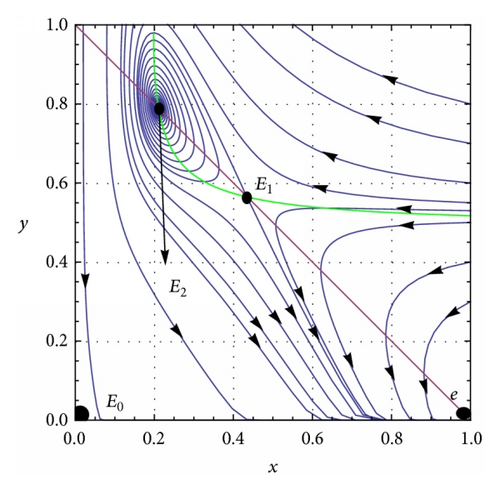
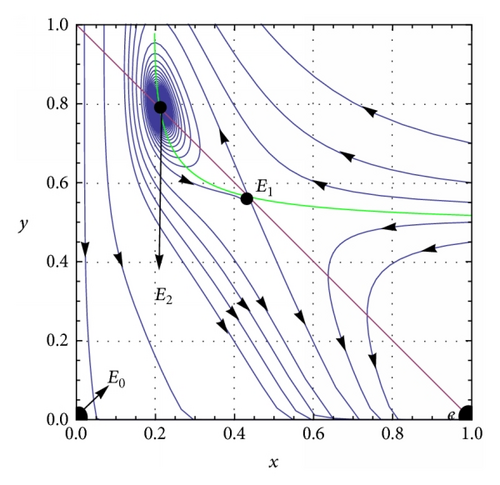
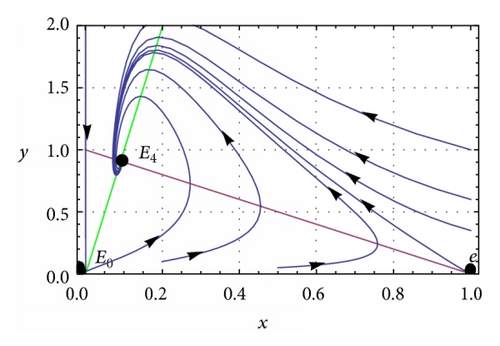

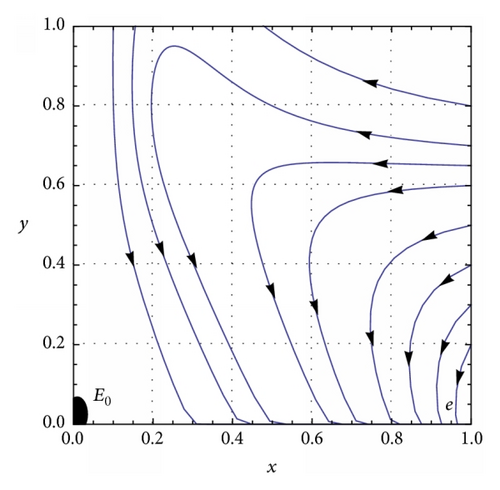
(b) β = 0.1, c = 0.01, h = 0.5, and then ρ∗ = 0.865973. System (5) undergoes Hopf bifurcation and the first Lyapunov coefficient σ = 214.922 > 0, so an unstable limit cycle arises around the equilibrium point E2 = (0.210806,0.789194). Here, we take ρ = 0.854 (see Figure 3(a)). β = 0.02, c = 0.1, h = 0.8, and then ρ∗ = 0.173169. System (5) undergoes Hopf bifurcation and the first Lyapunov coefficient σ = −762.219 < 0, so a stable limit cycle arises around the equilibrium point E2 = (0.0867959,0.913204). Here, we take ρ = 0.175 (see Figure 3(b)).
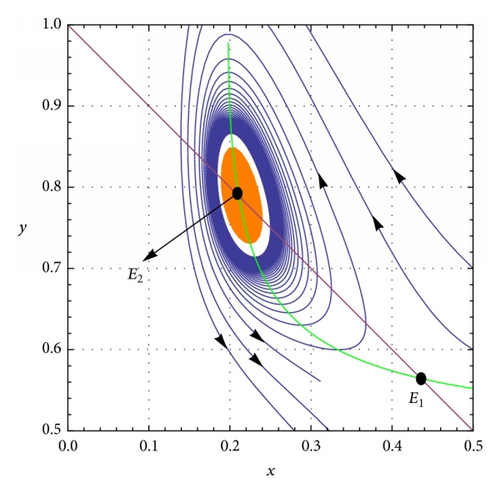
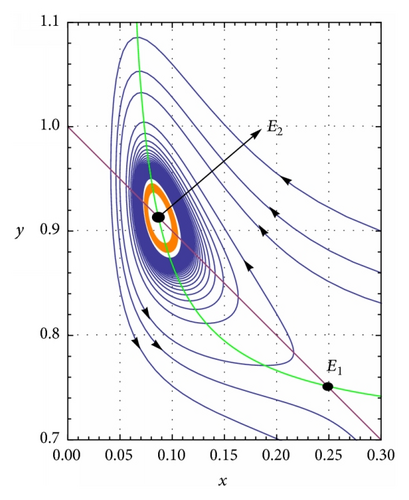
(c) β = 0.5, c = 0.1, ρ = 0.4, and . System (5) has a double interior equilibrium point which is a saddle node (see Figure 4(a)). The phase portrait diagram is shown in Figure 4(a) and the saddle-node bifurcation is shown in Figures 4(b) and 4(c).
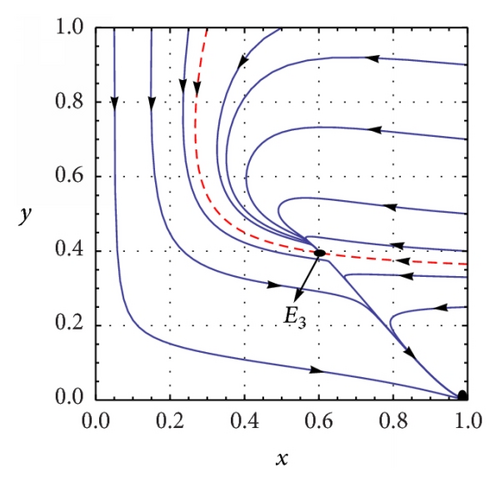
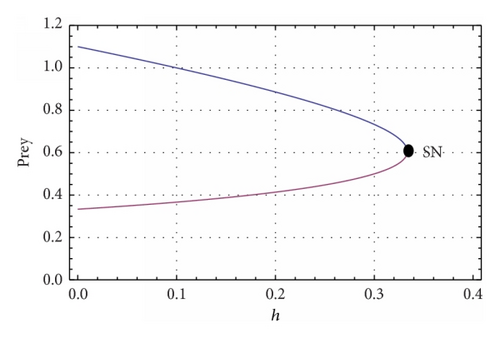
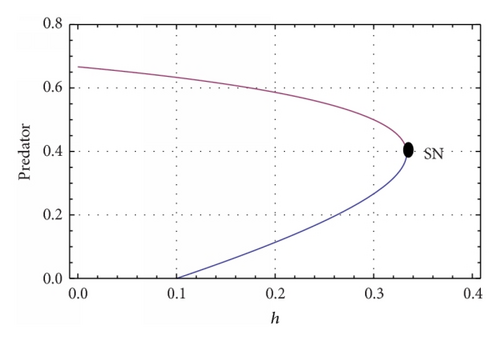
- (a)
SN = {(λ1, λ2) : μ1(λ1, λ2) = 0, μ2(λ1, λ2) ≠ 0}.
- (b)
- (c)
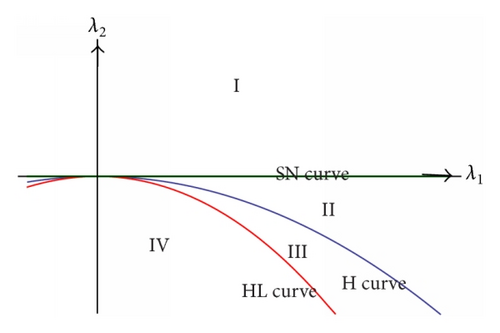
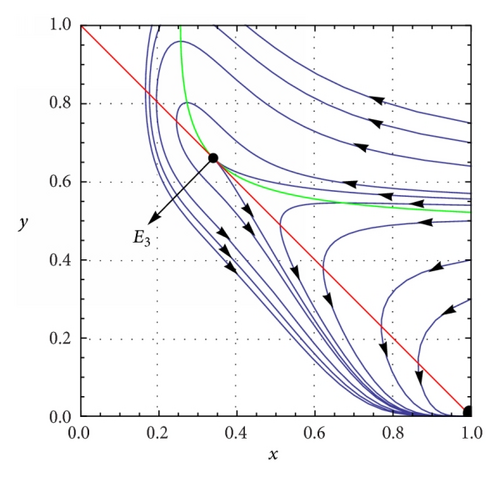
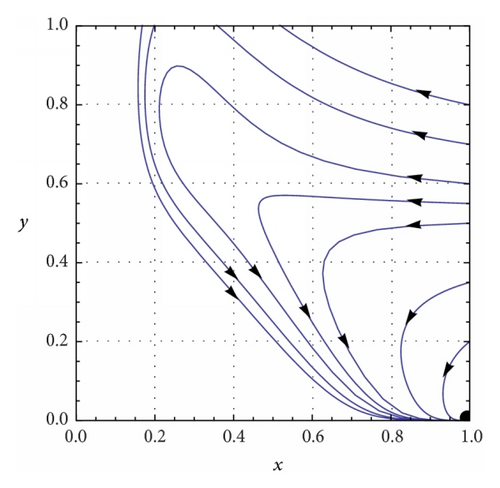
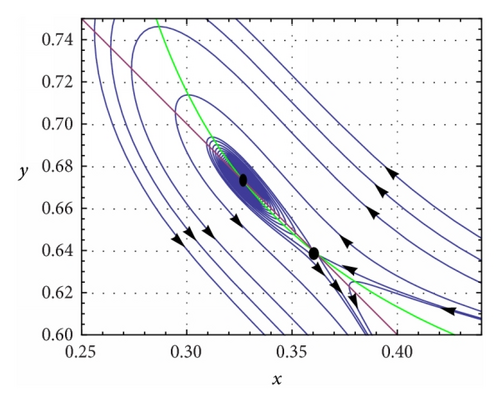
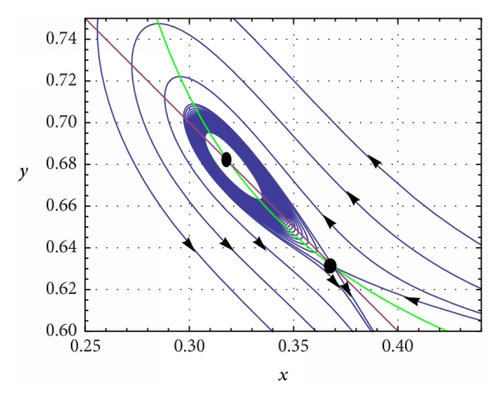
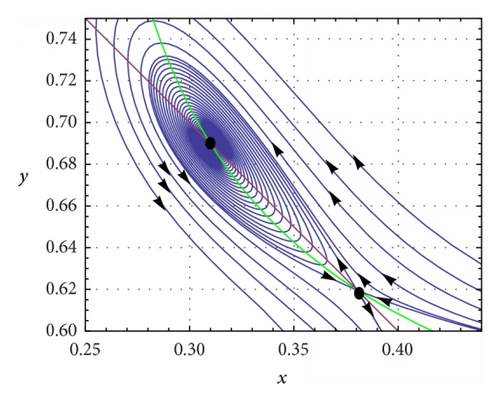
6. Discussion and Conclusion
In this paper, a Leslie-Gower predator-prey model has been analyzed in the presence of nonlinear predator harvesting. It is shown that the system has at most four equilibrium points in Ω, in which the trivial equilibrium point and the axial equilibrium point always exist while the positive interior equilibrium point changes from two to zero. The qualitative properties of solutions in the vicinity of (0,0) have been studied by using a blow-up technique, and it is found that the origin will never be stable; ecologically speaking, the two species cannot go to extinction together. The axial equilibrium point is either asymptotically stable or globally stable or a saddle depends on the parametric conditions. Thus, ecologically speaking, the prey species never goes to extinction whatever the choice of initial population density. If two interior equilibrium points exist, then one is always a saddle point while the other is either asymptotically stable or unstable or the system undergoes a Hopf bifurcation around this point; that is, for certain parametric domain, the system exhibits a bistability phenomenon as well as oscillatory coexistence of both the populations. The stability of limit cycles has been studied and validated through numerical simulations by calculating the first Lyapunov number. It is also found that for certain parametric domain the proposed system has a unique interior equilibrium which is globally asymptotically stable.
It is shown that the system can have zero, one, or two interior equilibrium points through saddle-node bifurcation as the bifurcation parameter h crosses a certain threshold value. By means of Sotomayor’s theorem, the existence of saddle-node bifurcation has been shown. Ecologically speaking, a maximum threshold value of h exists, below which both species coexist and above which predator species suddenly collapse to extinction. The proposed system undergoes Bogdanov-Takens bifurcation near degenerate equilibria. We have considered the parameters h and ρ as bifurcation parameters and reduced the system into normal form. Ecologically speaking, a small perturbation in the bifurcation parameters is a cause of extinction, coexistence, and oscillation.
The dynamical analysis of model (5) shows complex and rich dynamics as compared to the model with no harvesting [21] and with constant-yield predator harvesting [19]. The model without harvesting has a unique interior equilibrium point which is globally asymptotically stable [21] while model (5) has zero to two interior equilibrium points and model (5) undergoes a series of bifurcations (Hopf bifurcation, saddle-node bifurcation, and Bogdanov-Takens bifurcation). The model with constant-yield predator harvesting has no axial equilibrium point, and the solutions once touching the x-axis will leave the first quadrant [21]. But the model with nonlinear predator harvesting has one trivial equilibrium point E0 = (0,0) and one axial equilibrium point e = (1,0) and the solutions touching the x-axis will go to the axial equilibrium point e. Further, if no interior equilibrium point exists, then the axial equilibrium point e is globally asymptotically stable (see Figure 2(e)). Ecologically speaking, in the absence of predator species, the prey density approaches the carrying capacity. Although the model with constant-yield predator harvesting undergoes a series of bifurcations, like Hopf bifurcation, saddle-node bifurcation, and Bogdanov-Takens bifurcation [19], the model with nonlinear harvesting gives more general parametric conditions for the occurrence of these bifurcations. Thus, the results of nonlinear harvesting model can explain the real life situation in a more effective and realistic manner.
Competing Interests
The authors declare that they have no competing interests.




